Pros and Cons of Antler Point Restrictions
MSU Deer Lab & Bob Humphrey | Originally published in GameKeepers: Farming for Wildlife Magazine
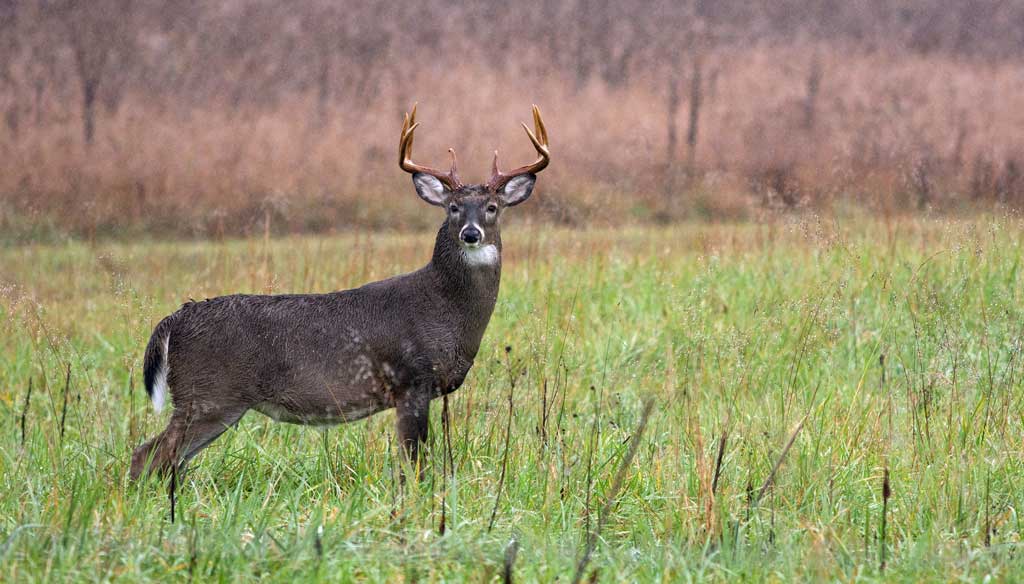
The application of deer management principles has come a long way in the past 20 years. Hunters in their 40s or older remember when either deer were hard to come by, or you saw only does and yearling bucks. Deer harvest regulations during the 1970s and early 80s were strategically designed to grow the deer population while allowing the harvest of bucks. According to plan, the deer population grew, and the intense harvest pressure on bucks insured they rarely lived past 1 ½ years of age.
By the late 1980s, deer managers shifted harvest regulations to control population growth by harvesting antlerless deer and to allow bucks to increase in prevalence and age. This approach for a more balanced, quality population became known as “Quality Deer Management” (QDM) and has been championed by the Quality Deer Management Association - promoting quality deer and quality deer habitats to support them. Keep the deer population in check relative to habitat quality, balance the sex ratio, and promote the survival of younger-aged bucks. The result is a more natural deer herd that provides a sustainable harvest of both bucks and does, with the benefit of producing older bucks with nice antlers – it’s a win-win!
Protecting young bucks and balancing sex ratios increased the buck age structure and provided hunters with more opportunities to harvest bucks with larger antlers and a more exciting hunt. The chase phase is more intent and you’re able to witness a more “natural” deer herd. Biologists and the many hunters that appreciated the measurable benefits of QDM called for widespread application of the principals, but not all hunters wanted to refrain from harvesting younger bucks. The answer to this dilemma was requiring protection of younger bucks by private landowners, and sometimes even development of regulatory mechanisms by legislatures or state agencies. But how could this be done? How could a wildlife agency or hunting club protect the yearling age class and most of the 2.5-year age class? The answer was antler restrictions.
How Antler Point Restrictions Work
Because antler size generally increases with age, deer managers use antler restrictions to protect one or more age classes of bucks on their property. Using age-specific antler development data from their region, they determine a minimum antler characteristic that will protect a majority of younger bucks, obviously with the assumption that most bucks with that characteristic would be below the minimum age. Implementing such an antler restriction will increase age structure of the bucks harvested. That is, after several years of protecting the yearlings from harvest, the average age of harvested bucks will certainly increase when compared to a property with unrestricted buck harvest.
To demonstrate how buck age structure and the average age of harvested bucks changes with implementation of an antler restriction, we’ll compare how age structure changes in two hypothetical populations of 500 bucks followed through 4½ years of age with and without an 8-point antler restriction (eight total antler points required to be eligible for harvest). In both cases, we’ll harvest 50 percent of the eligible bucks and assume a 10 percent non-harvest (such as accidents and disease) mortality rate. We used antler growth patterns from a higher quality soil region in Mississippi to simulate a real-world situation.
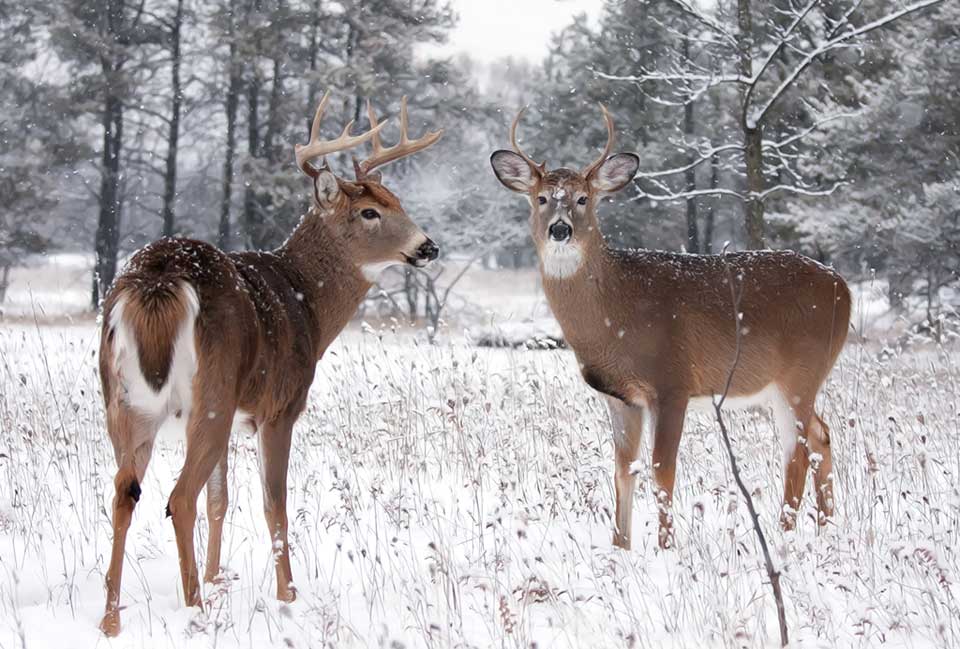
Antler Point Restriction Example
• 95 percent of the yearling bucks have fewer than eight total antler points;
• 38 percent of the 2½-year bucks have fewer than eight total antler points;
• 18 percent of the 3½-year bucks have fewer than eight total antler points, and
• 16 percent of the 4½-year and older bucks have fewer than eight total antler points.
First we’ll look at how a random harvest without an antler restriction will influence age structure of the population. Here’s how it works:
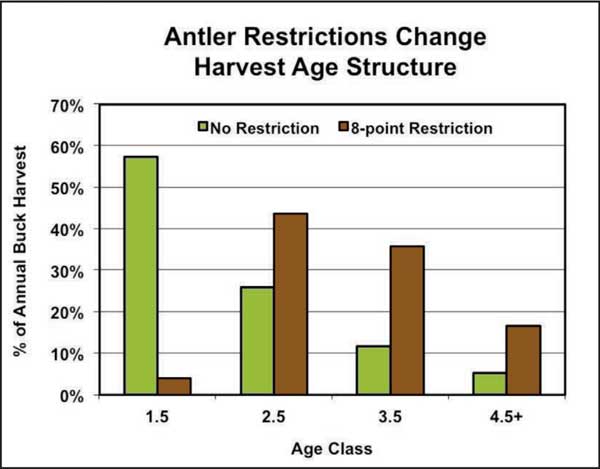
1) Start with 500 yearling bucks and randomly harvest 50 percent of them during the first hunting season.
2) At the end of the season, an additional 10 percent are removed to account for non-harvest mortality.
3) Move the surviving bucks to the second hunting season and randomly harvest 50 percent of them.
4) At the end of the second season, remove an additional 10 percent to account for non-harvest mortality.
Repeat the process for the third and fourth season, and you should see an age structure of harvested bucks similar to that in Figure 1.
Let’s look at the age distribution of the harvest without an antler restriction. Notice in Figure 1, more than 50 percent of the bucks harvested were yearlings and about five percent of the harvest were bucks 4½-years and older.
Antler Point Restriction vs. No Antler Point Restriction
1) Start with 500 yearling bucks, and randomly harvest 50 percent of the bucks that have eight or more antler points the first hunting season.
2) At the end of the season, remove an additional 10 percent to account for non-harvest mortality.
3) Move the surviving bucks to the second hunting season, and randomly harvest 50 percent of the bucks that have eight or more antler points.
4) At the end of the second season, remove an additional 10 percent to account for non-harvest mortality.
Repeat the process for the third and fourth season, and you should see an age structure of harvested bucks similar to that in Figure 1.
Notice that fewer than 5 percent of the bucks harvested with the 8-point antler restriction are yearlings, and the percentage of 2, 3 and 4-year old bucks has increased substantially. The biggest difference between the two simulations occurred in the 3-year age class, which was 13 percent of the harvest without the 8-point antler restriction and 24 percent with the antler restriction. So, the 8-point antler restriction worked as intended by protecting a large proportion of yearling bucks and allowing them to reach an older age class before being harvested.
The average age of harvested bucks also differed between the simulations, increasing from 2.1 years for randomly harvested bucks to 3.1 years for the 8-point antler restriction simulation. Our simulation showed the average deer harvested will be older, so the average deer harvested will have larger antlers. Remember that from two to three years of age, antlers improve from 60 percent of maximum up to 75 to 80 percent of maximum.
There’s no doubt using an antler restrictions can be a very effective management strategy to alter the age structure of the buck harvest and population. In many cases an antler restriction can accomplish the first step in many deer management programs – decrease the harvest of younger bucks. The challenge is developing an antler restriction that will protect younger bucks while allowing the harvest of older bucks in your particular area.
The main “management goal” of antler restrictions is to protect younger bucks, with the intent of harvesting them at older ages. Although the positive aspects of antler restrictions to protect young bucks are many, it is not without its pitfalls.
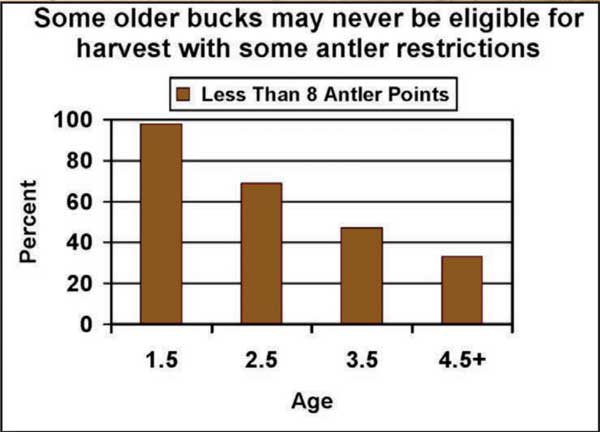
Antler Point Restrictions for Older Bucks
“There ain’t no such thing as a free lunch” is a common way to say “you can’t get something for nothing,” and this concept certainly applies to antler restrictions. It’s like Sir Isaac Newton’s law regarding force: for every action there is an equal and opposite reaction. For our discussion, the action is an antler restriction that can protect younger bucks from harvest also has the opposite reaction because older bucks with smaller antlers will also be protected from harvest…you just can’t get something for nothing.
The perpetual protection of bucks with smaller antlers will be a problem with any single antler restriction, but it is especially problematic when using more limiting antler restrictions designed to extend protection to 2-year-old bucks. For example, if an 8-point antler restriction were applied to moderate quality habitats in Mississippi, it would protect almost all yearling bucks and 70 percent of 2½-year bucks. However, it would also protect 34 percent of bucks 4-years and older. In other words, an 8-point antler restriction will create a class of perpetually protected mature bucks that would eat valuable forage and breed while better-quality bucks are harvested.
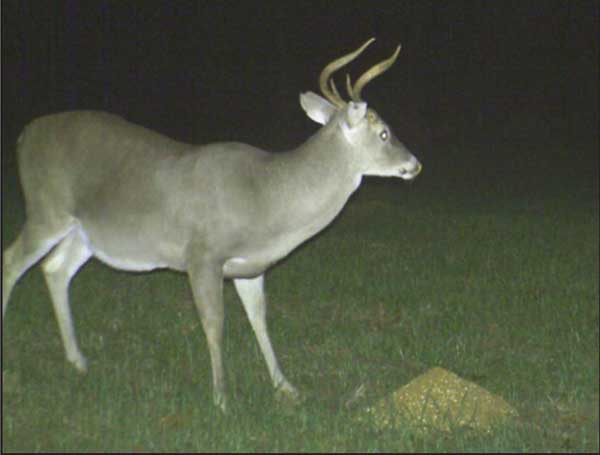
Improving Buck Age Structure
Simple antler restrictions will generally increase the age structure of deer populations, but hunters and managers must understand some of the biological realities when using these strategies.
Changing the buck age structure of a population takes a lot of acreage and many years. Realistically, you must have several thousand acres under a common management approach if you hope to alter the buck age structure much, but this large area does not have to be a single property. Adjacent properties that share similar management goals can form a cooperative and work together to manage the buck age structure in the population they hunt.
When managing buck populations, you want to protect some bucks while allowing the harvest of other bucks. Generally, you want young bucks to grow older, so age is the most important factor. The problem is that aging bucks based on a single physical feature leaves too much room for error. Longer beam lengths in the 1 year class overlap the shorter beam lengths in the 2 year class. Longer beam lengths in the 2 year class overlap the shorter beam lengths in the 3 year class. The pattern is identical when using body weight as the physical feature – inaccurate aging will be high when using any one physical feature to age (and selectively harvest) a buck.
To compound the problem with inaccurate aging, harvest based on a single factor could result in “high-grading” of the younger age class. Aging deer before harvest is difficult, but it’s critical to the success of advanced deer management programs. It should not be based on a single antler-based harvest factor.
Aging bucks before harvest should use a combination of physical features and requires a commitment to learning these identifying features. Check out the MSU Deer Lab’s website for a publication (A Hunter’s Guide to Aging and Judging Live White-tailed Deer in the Southeast) and an iPhone app to assist you with this task.
The simplest approach to age-structure management is to avoid harvesting any 1 or 2-year-old bucks. This solves many management problems. But because of the problems with antler restrictions, you can do this only by aging on-the-hoof using a variety of physical features.
Many hunters are satisfied with the size of antlers on older bucks, so all they need to do is protect all younger bucks. We like to tell hunters the best way to double the average antler size of harvested bucks is to let them live from one to two. Once you estimate an age, you can effectively apply antler-based harvest criteria within an age class with little potential for high-grading. In fact, properly designed antler restrictions applied within age classes can increase average antler size in older age classes.
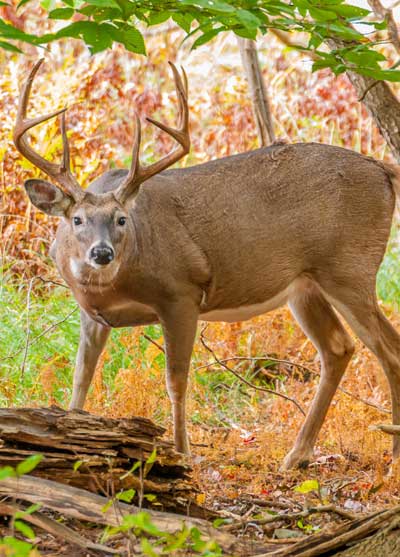 Texas is exceptional in so many ways, particularly when it comes to deer management.
Texas is exceptional in so many ways, particularly when it comes to deer management.
Relative antler size within an age class generally predicts future antler size, so selective removal of smaller-antlered bucks within an age class and protecting larger antler bucks within an age class should increase average antler size at older ages. It’s critical to note that you should target smaller-antlered young bucks for removal only when larger-antlered young bucks are in adequate supply and excess bucks need to be harvested. Harvesting spike bucks in some habitats could eliminate most of the yearling age class, thus dooming your buck age structure improvement program.
Antler restrictions designed to differentially remove smaller-antlered young bucks must be developed with careful consideration of their potential impacts. We emphasize that no one approach to antler-based harvest criteria can be universally applied.
Examples in this article are presented to clarify the variety of approaches available and are not necessarily appropriate to your specific management context. If you decide to use antler restrictions as part of your management program, be sure to develop an appropriate antler restriction. Having no antler restriction is better than having a poorly designed one.
A simple alternative to antler restrictions when managing for buck age structure is to limit the number of bucks harvested on a property. This approach is not the most efficient; plenty of bucks die naturally. An important point to remember is management goals vary, and harvest recommendations need to reflect these differences.
Using Multiple Criteria for Buck Harvest
There are probably more diverse antler restriction programs in Texas than in all other states combined, due in large part to the pattern of private land ownership and management. A lot of folks own or lease large tracts where they can more precisely control deer herd dynamics. Public land is a different story.
Recognizing some of the potential pitfalls of MARs, Texas Parks and Wildlife tried a slightly different approach in the Post Oak Savannah region of southeast Texas. The concept was well-accepted as interest among hunters and landowners was already high. With a dual goal of improving age structure and increasing hunting opportunity, they instituted a slot limit wherein a legal buck had to meet at least one of three criteria:
1) one unbranched antler,
2) a minimum 13-inch inside spread, or
3) at least six points on one side.
This system offered several advantages. The one unbranched antler criterion allowed for removal of cull bucks where other systems do not. Though culling spikes has proven largely ineffective and often unnecessary in most areas, Texas research has shown some positive effects on antler quality in poor quality habitat. The other two restrictions were to protect nearly all healthy yearling deer, and many in the 2.5-year age class that showed good antler development, effectively avoiding high-grading.
The proportion of yearling bucks harvested dropped from a previous 10-year average of 52 percent to 36 percent after the first season of restrictions, then to 28 percent the next season. Meanwhile, the proportion of 3.5-year-old bucks jumped from 16 to 25 percent the first season and 33 percent the second. And the proportion of 4.5-year-olds (4 percent under pre-restriction hunting), rose to 22 percent in the first two years. Landowners and hunters in the six-county area were ecstatic.
But again, no system is perfect and time often highlights flaws. Researchers began noticing that hunters seemed reluctant to “burn” their tags on spikes, particularly after observing the improved antler quality and availability of mature bucks. The simple solution was to allow hunters two bucks, one of which must have one unbranched antler.
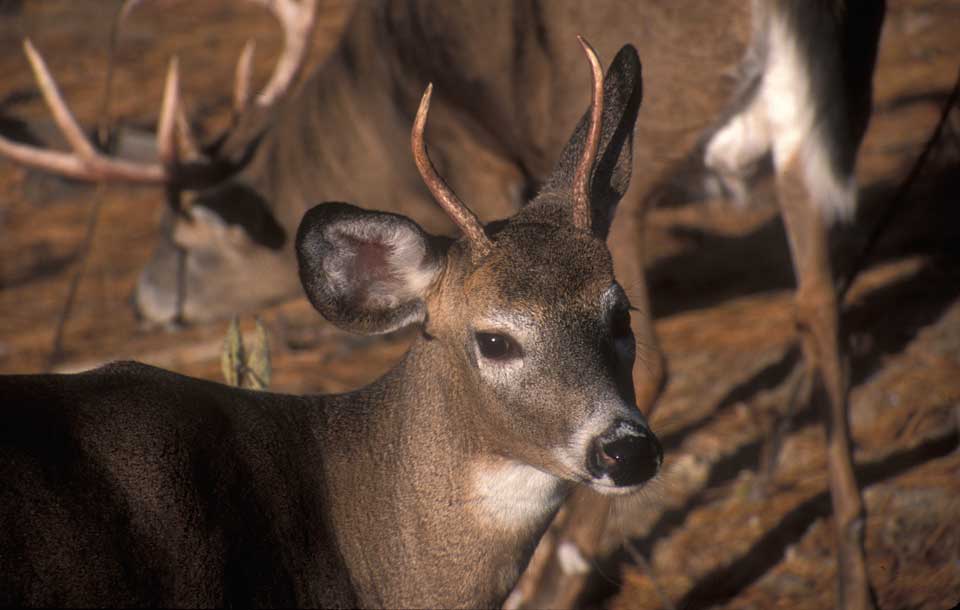
Summary
The many benefits of an older buck age structure justifies the effort in a good deer management program. But using a single-feature, one-size-fits-all antler restriction can create some biological problems and lead to disappointing results. Although most any antler restriction can be used to improve buck age structure, simple, one-characteristic restrictions will allow the harvest of bucks you want to protect (young bucks with large antlers), and protect bucks you want harvested (old bucks with small antlers). A properly developed antler restriction must fit an area’s unique biological and social circumstances, and hunters must be able to effectively apply the criteria. That is, it can’t be too complicated to apply in the field. The hunter-manager must be committed to continuing education and self-restraint. Gamekeepers serious about deer management must learn how to age bucks on-the-hoof and make harvest decisions only after age is determined. Only then will the right harvest decision be made.




























